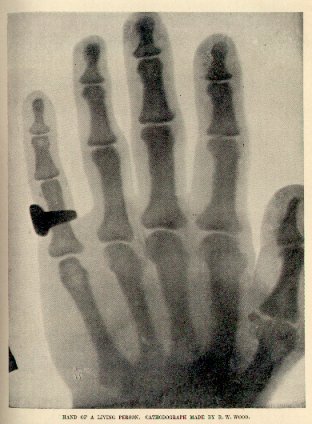We Discover X-rays
Today, a new discovery unleashes new hopes. The University of Houston's College of Engineering presents this series about the machines that make our civilization run, and the people whose ingenuity created them.
It was a great moment of serendipity. Wilhelm Roentgen was working with cathode ray tubes. He suddenly found he'd created a new kind of ray that could "see" through flesh, but not through bone. In 1895, Roentgen gave us the X-ray.
Seldom has anything so taken the public's imagination. Nancy Knight tells how this new marvel set the inventive muse in motion. Right away, magazine cartoons celebrated the idea. A man uses an X-ray viewer to see through a lady's hat at the theatre -- that sort of thing.
Soon we would all have X-ray viewers, and great the mischief would be. The very next year a company came out with lead panties to protect women from prying eyes. A would-be poet wrote,
Not worth your while
That false, sweet smile,
Which o'er your features plays:
Thy heart of steel
I can reveal
By my cathodic rays!
By the time I was a little boy, that'd turned into stories about Superman's X-ray eyes. Meanwhile, real X-rays were cheap and accessible. I didn't have X-ray eyes, but I could X-ray my feet in new shoes at the department store. That didn't last long. We were just catching on to the terrible hazards of X-rays.
So in 1896 futurists seized at the possibilities of seeing through opacity. That year, the president of Stanford University wrote about X-rays. He suggested we might soon use them to read thoughts. Was that satire or serious? We don't know.
Edison was deadly serious when he set out to focus enough X- rays on the human skull to watch the brain at work. He also proposed to heal tuberculosis with X-rays. Now, in a world of CAT-scans and radiation therapy, we hesitate to call Edison silly.
X-rays clearly attacked human tissue. So why shouldn't they attack germs? At first those destructive effects looked like one more benefit. When X-ray experimenters started losing hair, a French clinic opened up. It offered X-ray hair removal to women.
In fact, only weeks after Roentgen's discovery, a doctor in Chicago subjected a patient's breast cancer to X-rays. We wouldn't call that silly today.
So scientists and science fictionists alike seized this new marvel with the speed that's peculiar to the imagination. Roentgen had seemingly given us means to do what we've always craved to do. He gave us means to see through the dark -- to pierce the veil -- to know what we had once thought was unknowable.
I'm John Lienhard, at the University of Houston, where we're interested in the way inventive minds work.
(Theme music)
Knight, N., 'The New Light': X-rays and Medical Futurism. Imagining Tomorrow: History, Technology, and the American Future. (Joseph Corn, ed.) Cambridge, Mass.: MIT Press, 1986, Chapter 1.
For more on the new X-rays, see Episode 923.

From the 1895 Century Magazine
This X-ray photo appears in an article published in May of the year after Roentgen's discovery. The article is made up of letters from distinguished scientists of the day, including one where Edison analyses the construction of X-ray systems.